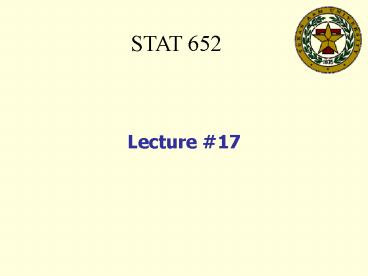STAT 652 - PowerPoint PPT Presentation
1 / 32
Title:
STAT 652
Description:
Gasket data ... selected from a large number of machines that are used to produce the gasket. The response is the number of gaskets (in thousand) produced. ... – PowerPoint PPT presentation
Number of Views:20
Avg rating:3.0/5.0
Title: STAT 652
1
STAT 652
Lecture 17
2
The Random Efeect Models
3
(No Transcript)
4
Examples
- A pharmaceutical company would like to examine
the potency of a liquid medication mixed in large
vats. - To do this, a random sample of five vats from a
months production was obtained, and four
separate samples were selected from each vat.
5
- Maternal ability of mice-response is weight of 10
day old litters. The data consists of 6 litters
from each of 4 dams, all of same breed. - Here we wont be interested in a particular dam
but more interested in the variation s²(A) from
dam to dam and the variation in litters from the
same dam s²(e).
6
Comparison of two Models
7
Estimating variance components
8
Possible Problem
9
Yield Data
- Manufacturer will often receive numerous batches
of raw materials for use in making chemical
compounds. - The manufacturer wishes to obtain a high yield
from each batch of raw material. - To determine the variability in yield due the
different batches, three sample determinations of
yield are made for each of five batches of raw
material.
10
Analysis
- MSTrVar (among batches)
- MSEVar (within batches)
- FMSTr/MSE20.5 (same as fixed effect) compare
with F(a,4,10) so reject H0 that s²(Batch)0. - Also 11.71/13.51.867 of the variation is due to
batches.
11
Two factor Models
- Both factors Fixed Factorial Experiment
- Both Factor random Random Effect
- One fixed, one random Mixed effect
- The E(MS) and corresponding F tests will depend
on the nature of the factor.
12
Two factor Random effects Model
13
(No Transcript)
14
(No Transcript)
15
Consequence of Model
16
Variance Components
- s²MSE
- s²(AB)MSAB-MSE/n
- s²(A)MSA-MSE-n s²(AB)/bn
17
Test For Interaction
18
Test for factor A
19
Test for Factor B
20
Estimation of Variance Components
21
Strength Data
- The factors that affect the breaking strength of
synthetic fiber are being studies. - Four machines are chosen at random from a large
population of machines, and three operators are
chosen random from a large population of
operators. - Two replications of a factorial experiment are
run using fiber from the same production batch. - The response is the breaking strength of the
fiber.
22
Analysis
- Test for Interaction F9.54/3.332.86.
F(6,12)3. so we fail to reject H_0 of no
interaction. - Now s²(AB)0 so need to perform a pooled test.
- MS(pooled)SSABSSE/61297.25/185.4
- F(Machine)10.5/5.4 compare with F(3,6) so not
significant - F(Operator)63.8/5.4 is significant.
- Half of the total variation is due to the
operators.
23
Mixed Effect Model
24
Also the interactions are independent to main
effect and error
25
Consequence of the Models
26
Expected Mean Squares
27
Test for Interaction
28
Test for Fixed Factor A
29
Test for Random Factor B
30
Estimation of Variance Components
ns²(AB)
31
Comparison of three models
32
Gasket data
- A company wishes to investigate whether the type
of gasket material affects the amount of
production of gaskets. - Three materials, cork, rubber and plastic are to
be studied. - Two machines were randomly selected from a large
number of machines that are used to produce the
gasket. - The response is the number of gaskets (in
thousand) produced.































